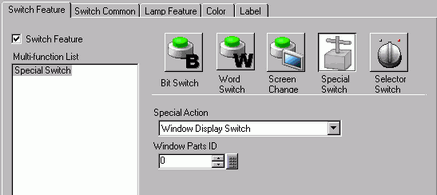

Special Action
Select the Special action.
Window Display Switch
This is the same as the Switch attached to a Window part which triggers the Window. Press the Switch and the designated Window displays. Press it again and the Window closes.
Alarm History Switch
This is the same as the Switch which is attached to the Alarm part. Creates a Switch to manage (Acknowledge/Move/Clear) the displayed Alarm History.![]() Alarm History Switch
Alarm History Switch
Text Alarm Switch
This is the same as the Switch which is attached to the Text Alarm part. Creates a Switch to show the displayed Text Alarm's scroll or Sub Screen.![]() Text Alarm Switch
Text Alarm Switch
Historical Trend Graph Switch
This is the same as the Switch which is attached to the Historical Trend Graph. Creates a Switch to display and scroll through historical data.![]() Historical Trend Graph Switch
Historical Trend Graph Switch
Sampling Data Display Switch
This is the same as the Switch which is attached to the Sampling Data Display part. Creates a Switch to scroll through a Sampling Data Display.![]() Sampling Data Display Switch
Sampling Data Display Switch
Switch for Selector List
This is the same as the Switch which is attached to the Text Alarm part. Create a scroll of the displayed list or a switch that operates the selected function.![]() Switch for Selector List
Switch for Selector List
Operation Lock
When multiple display units are connected to one PLC via GP-Viewer EX or Ethernet, as one display unit/GP-Viewer EX starts its operation, you cannot operate with another display unit/GP-Viewer EX. It can be used for canceling "disable."![]() Operation Lock
Operation Lock
Security
Create a switch to change a password while communicating with the Device/PLC.![]() Security
Security
File Item Switch
This is the same as the Switch which is attached to the Special Data Display [Filing]. Creates a Switch to transfer filing data, scroll through a Filing Display, and so on.![]() File Item Switch
File Item Switch
File Manager Display Switch
This is the same as the Switch which is attached to the Special Data Display [File Manager]. Creates a Switch to display the File Manager on the screen.
Data Transfer Switch
This is the same as the Switch which is attached to the Special Data Display [Data Transmission]. Creates a Switch to transfer CSV data, scroll through a Data Transfer Display, and so on.![]() Data Transfer Switch
Data Transfer Switch
Switch for CSV Display
This is the same as the Switch which is attached to the Special Data Display [Show CSV]. Creates a Switch to scroll through a CSV Display or print CSV data.![]() Switch for CSV Display
Switch for CSV Display
Movie Player Switch
This is the same as the switch attached to the movie player. Create the switch to operate the screen for movie playback.![]() Movie Player Switch
Movie Player Switch
Start monitor switch
Create a switch to display the Device monitor and the Ladder monitor on the screen.![]() Start monitor switch
Start monitor switch
Application Trigger
Create a switch to directly specify and start the application executable file when using WinGP. You can specify settings such as the startup parameters and the watch on multiplex start.![]() Application Trigger
Application Trigger
Exit WinGP
Create a switch to exit WinGP.![]() Exit WinGP
Exit WinGP
Reset
Create a switch to reset the Display.
Offline
Create a switch to transfer to offline mode (no communication with the device/PLC) for the Display.
![]()
[Reset] and [Offline] cannot be set on a multifunctional switch (multiple operations with one switch).
Remote PC Access window display Switch
This is the same as the switch attached to the Remote PC Access Window Display. Display the RPA Window Screens on the screen.![]() 36.3 Display or Operate a Computer from the Display Unit
36.3 Display or Operate a Computer from the Display Unit
Transfer Device/PLC Data
Create a switch to display the Transfer Device/PLC Data screen, used for transferring from display unit to device/PLC.
![]()
Because data such as a PLC ladder program can be transferred, we recommend setting security on the switches and on the screen where switches are placed to prevent malfunctions. For more information on security settings, refer to the following.![]() Chapter 22 Enhancing Security
Chapter 22 Enhancing Security
For the list of drivers that support Transfer Device/PLC Data and the detailed driver settings, please see the "GP-Pro EX Device/PLC Connection Manual".
Window Parts ID
Set the ID of the Window to display when the switch is touched. 0 to 3833 is the set up range.

Action
Select the alarm history switch operation: [Start], [End], [Acknowledge], [Move], [Clear], [Sort], [Scroll], [Sub Display], or [Alarm Number Acquisition Key].
Freeze Mode
When the [Action] is [Start], designate whether or not to use Freeze Mode (stops the Alarm display in the current state and does not perform updates).
Detail Action
When [Action] is selected as [Acknowledge], [Move], [Clear], or [Sort], select the details.
Acknowledge
Choose from [Acknowledge] or [Check All].
Move
Choose from [Move Upward], [Move Downward], [Scroll Up], or [Scroll Down].
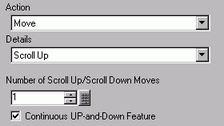
Clear
Choose from [Clear], [Clear All], [Clear Recovered Alarm], [Clear Acknowledged Alarm], [Clear All Recovered Alarm], [Clear All Number of Occurrences Fields], [Clear Individual Number of Occurrences Fields], [Clear All Accumulated Time Field] or [Clear Individual Accumulated Time Field].
Sort
Choose from [Sort by Triggered Date and Time], [Sort by Number of Occurrences], [Sort by Accumulated Time], [Alarm Sort by Registration Order], [Sort by Level & Date and Time], [Sort by Level & Number of Occurrences], or [Sort in Reverse].
Scroll
Select either [Scroll Right] or [Scroll Left].
Continuous Move Feature
When [Detail Action] is selected as [Move Upward] or [Move Downward], select whether or not to move continuously while the Switch is pressed.
This function does not exist on the Alarm part.
Number of Scroll Up/Scroll Down Moves
When [Detail Action] is [Scroll Up] or [Scroll Down], set the number of moves the Switch will scroll when pressed once. The setting range is from 1 to 768.
Continuous Up-and-Down Feature
When [Detail Action] is selected as [Scroll Up] or [Scroll Down], select whether or not to scroll up (or down) continuously while the Switch is pressed.
This function does not exist on the Alarm part.
Get Operation Log
When [Action] is selected as [Acknowledge] or [Clear], specify whether to get the operation log.
![]()
When [Enable Operation Log Function] is not selected from the [Common Settings] menu's [Operation Log Settings], the message "Unable to include in operation log of individual parts" will appear. Select [Enable Operation Log Function] to enable the operation log settings.
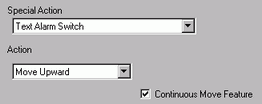
Action
Choose the action from [Move Upward], [Move Downward], [Scroll Up], [Scroll Down], [Sub Display], or [End].
Continuous Move Feature
When [Detail Action] is selected as [Move Upward] or [Move Downward], select whether or not to move continuously while the Switch is pressed.
This function does not exist on the Alarm part.
Number of Scroll Up/Scroll Down Moves
When [Action] is [Scroll Up] or [Scroll Down], set the number of moves the Switch will scroll when pressed once. The setting range is from 1 to 512.
Continuous Up-and-Down Feature
When [Action] is selected as [Scroll Up] or [Scroll Down], select whether or not to scroll up (or down) continuously while the Switch is pressed.
This function does not exist on the Text Alarm part.

Action
Select the Display Historical Data switch operation for the Historical Trend Graph: [Display Historical Data Switch], [Scroll for Old Data], [Scroll for New Data], [Zoom Display], and [Zoom Out Display].
Samples to Scroll
When [Action] is [Scroll for the Old Data] or [Scroll for New Data], set the number of samples to scroll with one touch. The setting range is from 1 to 65535.
Continuous Scroll Feature
When [Action] is [Scroll for the Old Data] or [Scroll for New Data], designate whether or not to scroll continuously when the Switch is pressed.
This feature does not exist on the Historical Trend Graph part.
Use only in Display Historical Data
When [Action] is selected as [Zoom Display] or [Zoom Out Display], specify whether to use it only when displaying Historical Data.
Historical Trend Graph Parts ID
When [Action] is selected as [Zoom Display] or [Zoom Out Display], set the historical trend graph parts that reflect the display condition.

Action
Choose the action from [Scroll Up], [Scroll Down], [Scroll Left], or [Scroll Right].
Samples to Scroll
Set the number of samples to scroll when pressed once. The setting range is 1 to 65,535 for [Scroll Up] and [Scroll Down], and 1 to 514 for [Scroll Left] and [Scroll Right].
Continuous Scroll Feature
Designate whether or not to scroll continuously when the Switch is pressed.
This function does not exist on the Sampling Display part.
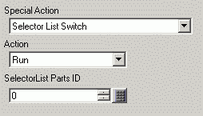
![]()
Please refer to the following for the models that support the Special Switch's [Selector List Switch] action.![]() 1.3 Supported Features
1.3 Supported Features
Action
Choose the switch action that operates selector list from [Run], [Move Upward] or [Move Downward].
Get Operation Log
When selecting [Run] as the [Action], specify whether to get the operation log.
![]()
When [Enable Operation Log Function] is not selected in the common settings [Operation Log Settings], the message "Unable to include in operation log of individual parts" will appear. Select [Enable Operation Log Function] to enable the operation log settings.
Selector List Parts ID
Specify the selector list part ID associated with the switch.
![]()
When the selector list is displayed and Visibility animation set up on the switch hides the switch, the selector list will close. When the switch becomes visible again, the list will remain closed.
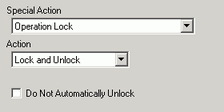
Action
Choose the action of operation lock switch from [Lock and Unlock], [Lock] or [Unlock].
Do not automatically unlock.
When selecting, the lock does not automatically unlock even after the time set in [Time Out] in [Operation Lock Settings] in the Display Unit [Extended Settings] has passed.
Get Operation Log
When selecting [Run] as the [Action], specify whether to get the operation log.
![]()
When [Enable Operation Log Function] is not selected in the common settings [Operation Log Settings], the message "Unable to include in operation log of individual parts" will appear. Select [Enable Operation Log Function] to enable the operation log settings.
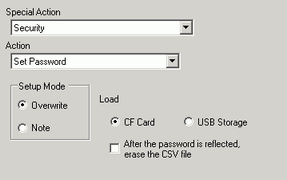
![]()
Please refer to the following for models that support the online password editing.![]() 1.3 Supported Features
1.3 Supported Features
Action
Choose the action of the set password switch: [Set Password], [Log In] or [Log Off].
Setting Mode
When [Set Password] is the defined [Action], select [Overwrite] or [Add].
Overwrite
Overwrite the password that was read-in to the existing passwords.
Add
Add the password that was read-in to the existing passwords.
Load
Choose where to load the password from: [CF Card] or [USB Storage].
After reflecting the password, delete the CSV file.
After showing the password from the [Load] operation, specify whether to delete the CSV file.
Log Off Screen
When selecting [Log Off] as the [Action], choose the log off screen from [Start Screen], [Select Screen], or [No Screen Movement].
Screen
When using [Select Screen], specify the screen number to display when logging off.
Get Operation Log
Specifies whether to record the Operation Log.
![]()
When [Enable Operation Log Function] is not selected in the common settings [Operation Log Settings], the message "Unable to include in operation log of individual parts" will appear. Select [Enable Operation Log Function] to enable the operation log settings.
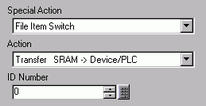
Action
Choose the action of the switch in the Special Data Display [Filing]: [Transfer from SRAM to Device/PLC], [Transfer from SRAM to Internal Device], [Transfer from Device/PLC to SRAM], [Transfer from Device/PLC to Internal Device], [Transfer from Internal Device to SRAM], [Transfer from Internal Device to Device/PLC], [Move Upward] or [Move Downward].
ID Number
Set the ID number of the Special Data Display [Filing] you want to operate with the Special Switch. The value can be from 0 to 255.
Number of Moves
When [Action] is [Move Upward] or [Move Downward], set the number of moves for one touch from 1 to 2,048.
Continuous Move Feature
When [Action] is selected as [Move Upward] or [Move Downward], select whether or not to move continuously while the Switch is pressed.
This feature does not exist on a Special Data Display [Filing].
Get Operation Log
Specifies whether to get the operation log when one of the following actions occur: [Transfer from SRAM to Device/PLC], [Transfer from SRAM to Internal Device], [Transfer from Device/PLC to SRAM], [Transfer from Device/PLC to Internal Device], [Transfer from Internal Device to SRAM], or [Transfer from Internal Device to Device/PLC].
![]()
When [Enable Operation Log Function] is not selected in the common settings [Operation Log Settings], the message "Unable to include in operation log of individual parts" will appear. Select [Enable Operation Log Function] to enable the operation log settings.

Action
Select the switch operation for the Special Data Display [Data Transmission]: CF/USB to Device/PLC], [Transfer from Device/PLC to CF/USB], [Scroll Up], [Scroll Down] or [CSV Data Display].
Samples to Scroll
When [Action] is [Scroll Up] or [Scroll Down], set the number of moves for one touch from 1 to 100.
Continuous Scroll Feature
When [Action] is selected as [Scroll Up] or [Scroll Down], select whether or not to move continuously while the Switch is pressed.
This feature does not exist on a Special Data Display [Data Transmission].
Get Operation Log
Specifies whether to get the operation log when [Transfer from CF/USB to Device/PLC] or [Transfer from Device/PLC to CF/USB] is selected as the [Action].
![]()
When [Enable Operation Log Function] is not selected in the common settings [Operation Log Settings], the message "Unable to include in operation log of individual parts" will appear. Select [Enable Operation Log Function] to enable the operation log settings.

Action
You can set the Special Data Display [CSV Display] switch's action to [Scroll Up], [Scroll Down], [Scroll Left], [Scroll Right], [Print-All], or [Print-Display].
Samples to Scroll
When selecting [Scroll Up], [Scroll Down], [Scroll Left], or [Scroll Right], set the number of moves for one touch from 1 to 1000.
Continuous Scroll Feature
When [Action] is selected as [Scroll Up], [Scroll Down], [Scroll Left] or [Scroll Right], select whether or not to move continuously while the Switch is pressed.
This feature does not exist on a Special Data Display [Show CSV].

Action
Select the switch function for playing a movie with [Movie Player] from [Play], [Stop], [Pause], [Fast Forward], [Rewind], [Slow Motion], [Forward 1 Frame], [Back 1 Frame], [Change Movie], [Zoom], [Move], or [Video Display].
Speed
When selecting [Slow Motion] under [Action], specify the play speed from [x 1/2], [x 1/4] or [x 1/8].
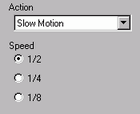
Step Forward Settings
When the [Action] is set to [Forward 1 Frame], select [Multiple Frames] or [Single Frame]. This switch can be used only in the pause state.
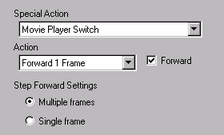
Forward (Backward)
When selecting [Forward 1 Frame] (or [Back 1 Frame]) under [Action], while holding down the switch, specify whether to continuously forward (or reverse) the movie frame by frame.
Detail Action
When selecting [Change Movie] as the [Action], select [Next], [Previous], or [Specify Range].
Loop
When selecting [Next] or [Previous], specify whether to loop the file.
Specify Range
Specify the Index Number from 0 to 99 of the movie to play.
When selecting [Move] under [Action], select [Top], [Bottom], [Left], or [Right]. The following describes the range in which a movie can be moved at one time.
|
Direction |
When playing an SDX file |
When playing a video |
|---|---|---|
|
Landscape direction |
2 dot unit |
2 dot unit |
|
Portrait direction |
Normal size 2 dot unit 1/4 and 1/16 sizes 1 dot unit |
1 dot unit |
Continuous
While holding down the switch, specify whether to move the movie.
Detail Action
When selecting [Video] as the [Action], select [Video ON], [Video OFF], or [Video ON/OFF].
Action Mode
When selecting [Zoom] as the [Action], select [Direct] or [Indirect].
Display size
When selecting [Direct], select the display size from [Normal], [1/4], [1/ 16], or [Zoom].
The [Zoom] option zooms a movie in or out in this order: Normal -> 1/4 -> 1/16 -> 1/4 -> Normal, and so on, each time the switch is pressed. [Loop], when selected, zooms the movie in and out in the order of "Normal -> 1/4 -> 1/16 - Normal -> 1/4...".
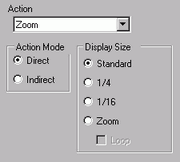
Word Address
Designate an address to store the display size when [Indirect] is selected.
The display sizes are as follows.
0: Standard
1: 1/4
2: 1/16
3 to 0xFFFE Reserved (no change)
0xFFFF: Normal (return to the main screen)

Action
Select from [Ladder monitor], [Ladder monitor (Cache)] or [Device monitor].
Ladder Monitor
Start the ladder monitor screen. The ladder is displayed after start and [Read]. The ladder is not displayed at start up.
Ladder Monitor (Cache)
Displays the previous ladder saved on the CF card upon exiting.
Device Monitor
Start the Device monitor screen.![]() A.2 Monitoring the Value of Device Addresses (Device Monitor)
A.2 Monitoring the Value of Device Addresses (Device Monitor)
![]()
To use the Ladder monitor, you need the ladder monitor tool (sold separately) on your PLC. Refer to the ladder monitor operation manual in the ladder monitor CD-ROM.
Get Operation Log
Specifies whether to record the Operation Log.
![]()
When [Enable Operation Log Function] is not selected in the common settings [Operation Log Settings], the message "Unable to include in operation log of individual parts" will appear. Select [Enable Operation Log Function] to enable the operation log settings.
Use the Start Application switch for starting the application by touch when using WinGP.
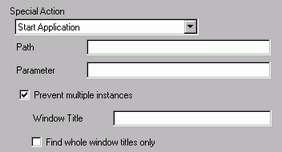
EXE path
Input the absolute path of the executable file (.exe) you want to start. You can input up to 255 characters.
Parameter
Input the argument of the executable file on start up. You can input up to 255 characters.
Prevent multiple instances
Set [Window Title] to watch multiple instances. You can input up to 63 characters.
If a window matching [Window Title] is found, the application does not start. In [Window Title], if there are no settings in this field, multiple starts are allowed.
Find whole window titles only
If a window matching the title specified in [Window Title] is found, the specified application does not start.
Get Operation Log
Specifies whether to record the Operation Log.
![]()
When [Enable Operation Log Function] is not selected in the common settings [Operation Log Settings], the message "Unable to include in operation log of individual parts" will appear. Select [Enable Operation Log Function] to enable the operation log settings.
Exit WinGP.

Display Confirmation Dialog Box
Display a confirmation dialog when exiting WinGP.
Get Operation Log
Specifies whether to record the Operation Log.
![]()
When [Enable Operation Log Function] is not selected in the common settings [Operation Log Settings], the message "Unable to include in operation log of individual parts" will appear. Select [Enable Operation Log Function] to enable the operation log settings.